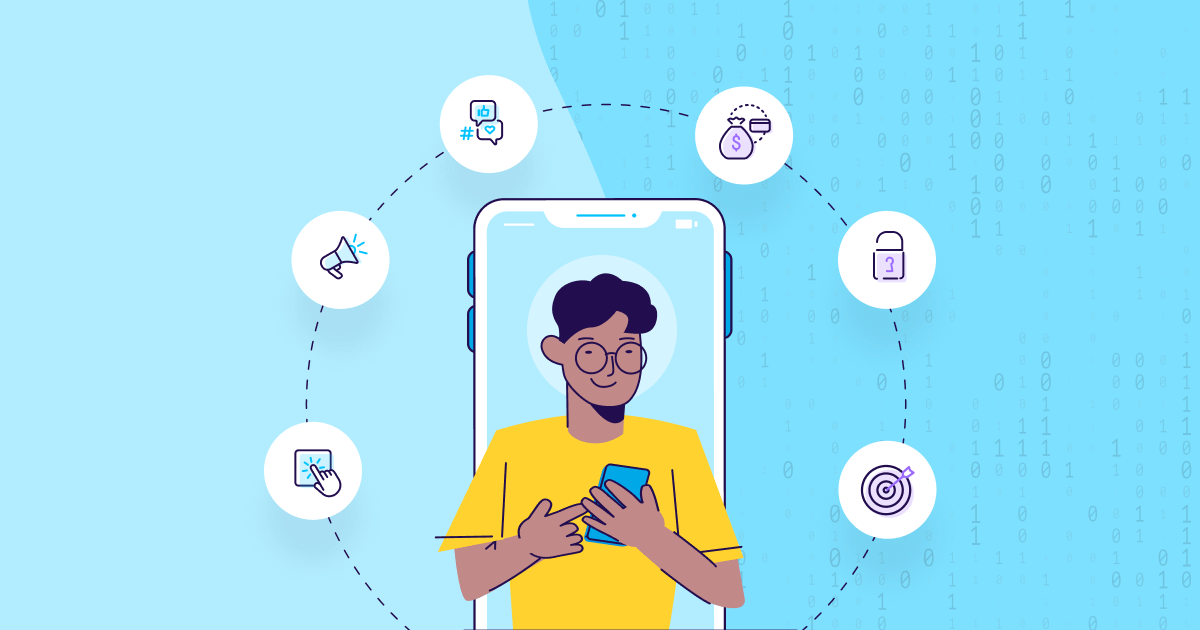
Introduction
With 3.5 million apps on Google Play and 2.1 million apps on the Apple App Store, how do you stand out? Is there a method to the mobile app madness? Well, yes and it’s called app marketing.
The way apps are used, sold, and marketed has changed dramatically over the years — which presents a unique opportunity for marketers to capitalize on.
While the days where 99 cent apps provided unlimited access are long gone, free apps are monetized through subscriptions, micro transactions, and in-app purchases, making the app marketplace one of the most lucrative opportunities for advertisers and developers today.
So even if you may feel that the ultimate goal of app marketing is to drive installs, bear in mind that a successful campaign also increases retention, usage, and ultimately spend on the app.
In this guide, we’ll cover everything you need to know about app marketing — from the fundamentals to practical expert tips and trends, all designed to help you create the next golden goose app.

What is app marketing?
App marketing is the method of building awareness, acquiring new users, and retaining ones through advertising, placements, and promotions.
The difference between mobile app marketing and mobile marketing
One of the most common mistakes marketers make is confusing mobile app marketing with mobile marketing.
Mobile marketing is the broad definition of all things related to advertising, promoting, and marketing using a mobile device as a medium. This can include SMS marketing, email marketing, and marketing using notifications.
On the other hand, mobile app marketing is the promotion of a specific app.
The difference between app marketing and app advertising
App advertising is a paid methodology utilizing channels like in-app ads, banner ads, text ads, and rich media mobile ads. Mobile app marketing, however, encompasses both organic and paid methods to acquire, retain, and convert users.
Types of app marketing

There are numerous ways to get your app out there. What’s important to keep top of mind is that your direction is more important than your speed. You can’t just go out there and wing it! Your time and money is more valuable than that.
To help you strategize, here’s a brief overview of the different ways to market your app today.
But remember, every app serves a unique purpose and audiences, so make sure you explore options that makes the most sense to you
App Store Optimization
App Store Optimization, or ASO for short, is the process of optimizing your app store presence to drive more downloads. It’s essentially the same concept as SEO, but for apps.
In other words, ASO helps your app get more eyeballs to your app store page, show up for relevant keywords, and drive as many installs as possible.
Compared to paid campaigns, successful ASO leads to a continuous stream of new, and more engaged organic users.
Marketing your app on social media
Social media is a powerful tool to build your brand both organically and through paid channels.
Pokemon Go is an excellent example of this. Organically, they post tutorials, visual guides, and secret event drops that continue to engage their most loyal players.
Their paid advertising adds another dimension to their marketing mix, by promoting new events and enticing offers to new and returning players. The combination of the two makes Pokemon Go one of the highest grossing mobile games, generating over $887 million in 2021 alone.
What is influencer marketing?
Growing an organic audience on social media is getting harder by the day. Paid traffic is becoming more competitive and free organic reach is becoming increasingly limited across all social media channels.
This is why brands are partnering with influencers to increase their brand awareness and drive conversions, by having an influential celebrity, online persona, or industry expert endorse your app.
And when you look at the numbers, leveraging an influencer marketing strategy makes complete and total sense. 61% of consumers trust influencers, while only 38% trust messaging directly from brands, driving the influencer marketing industry to be valued at a record $16.4 billion.
What is in-app advertising?
In-app advertising (IAA) is the monetization strategy where app developers get paid to serve ads in their mobile app, which has become a critical revenue stream for app developers in a freemium-dominated market.
IAA allows app marketers to reach relevant users in tangential spaces at the right time. If you think about it, casual gamers are more likely to download other casual games and so on.
App marketing visualized – The app marketing funnel
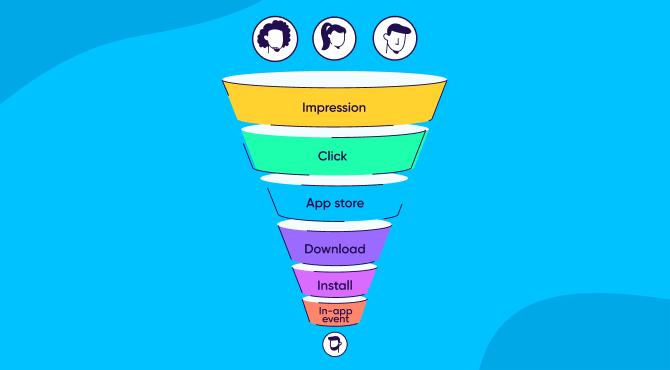
There are two ways to conceptualize how app marketers can reach and convert new audiences. These pathways are called funnels — and there are two main types:
The first is the classic three-step journey, where a potential user starts at the awareness stage, moves to the acquisition stage, and ends at the retention phase.
This is often more broadly applied to marketing strategies even outside of app marketing.
The second funnel is the user journey — that is more specific to app marketing. It starts with an impression, then clicks, app store, download, install, and ends with an in-app event.
Although the two funnels coincide with each other, they do serve two different levels of specificity:
- Impressions fall under the awareness stage
- Clicks, app store, download, and install — all fall under the acquisition stage
- In-app events fall under the retention stage
Don’t worry if that’s a little confusing. Let’s dive into each stage in more detail.

Awareness – Get your name out there
Let’s start at the very top: attracting new potential users to your app, aka the awareness phase.
This is the critical stage where you try to build your reputation, buzz, and general awareness — to maximize visibility, build recognition, and make it easier for the user to reach a decision.
The awareness stage generally starts very broad, which is why it pays off to dedicate your resources into understanding your target audience before anything else.
Be your audience’s friend, therapist, expert, and consultant
The very first step is to start formulating your who, when, why, where, and how. Begin by asking yourself the following questions:
- What problem is my app solving?
- Who faces these problems?
- What content does this audience engage with online?
- What age group am I targeting?
- What competing apps can I draw inspiration from?
- Is my app designed to entertain, educate, or serve as a luxury item?
The next step is to challenge and bolster your hypothesis by speaking with your users.
Conduct surveys, but if you can, try to engage a power user. Ask deep questions and make sure you’re challenging your own biases. If you have the budget to do so, consider focus groups as well.
Explore organic marketing channels and owned media
You can now decide on a channel where your audience lives based on your research.
In the awareness stage, it’s integral that you devise a strategy that doesn’t spread your resources too thin, but also allows you to test as many channels as possible.
Creating an organic marketing strategy on your owned channels is crucial. Whether it’s growing an email list or building a TikTok following, this is a great opportunity to start spreading the word — naturally.
Here are some tips to help you get started:
- Treat your profile like a landing page. Be clear about what you do, update your profile image and banners, provide a clear CTA, and add your contact information.
- Conduct competitive research. Have a look at the top performing posts from competitive apps and draw inspiration from their tone, copy, style, and content formats. Inspiration can also include what you don’t like or are missing in their owned media strategy.
- Experiment with things that don’t scale. Sometimes it’s sending personalized DMs to smaller creators for collaboration opportunities or asking your audience questions about what they want to see.
Whatever your content play is, make sure that you’re always testing new formats and creating content that best resonates with the audience’s pain points you’ve listed above.

Acquisition – Driving App Installs
Now that you’ve established your presence online, it’s time to kick up a notch and devise a strategy to get more users to download your app.
In the acquisition stage, the focus is on generating installs through both paid and organic channels. You can take several directions when it comes to placing your focus on a few key strategies, which we’ll go over in just a bit:
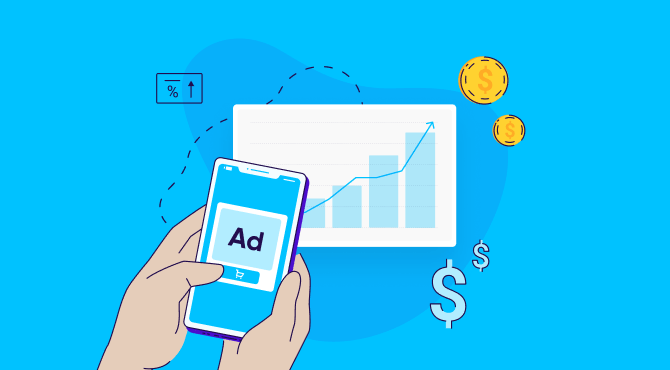
Paid advertising
An effective paid strategy is a well-tested one. Whether you’re investing in TikTok, Snapchat, or Instagram — your messaging, creatives, and targeting have to be fine-tuned over time.
A successful paid strategy begins by owning clear KPIs. A firm grasp of what to test, measure, and define success with — is key to getting the most out of your ad budget.
Some paid ads strategies could include making a lookalike audience from your highest-paying users. Or consider remarketing campaigns to offer special promotions to users who haven’t engaged with your app for a while.
App Store Optimization
As discussed in Chapter 1, ASO is the process of optimizing your app store to drive more traffic and installs. Now let’s get a little bit more tactical.
Here are a few ways you can get started with App Store Optimization today:
- Be clear about defining your app’s target audience. Identify their demographics, roles, and characteristics — to nail down your messaging.
- Conduct competitive research to see what has been working and not working for competitors in your niche.
- Research keywords that describe and solve your audience’s core problems. Consider using keyword tools like AppTweak or AppRadar to help.
- Validate your keywords by using these three criteria:
- Relevance – how specific is this to my audience?
- Difficulty or competition – how competitive is it to rank for this keyword?
- Search volume – how many people search for this keyword, if any at all?
- Integrate your keywords naturally into your app store product page.
For a full step-by-step breakdown on how to execute this, read our ASO guide here.

Chapter 4
Garnering loyalty – Retention & engagement strategies
As the old adage goes, it’s cheaper to retain a customer than to acquire a new one. In today’s world where apps are driven by in-app purchases and subscriptions, building a loyal user base serves as the absolute holy grail for effective monetization.
There’s good news and bad news when it comes to retention and churn. Bad news first. 50% of uninstalled apps were deleted because they weren’t in use. The good news? 90% of users are more likely to continue using an app if they engage with it at least once a week.
So how do you stop being just an untouched logo on the third page of someone’s home screen? Here are a few strategies to get you going:
Provide a concierge onboarding experience
First impressions are everything. If you show up to your first date late and unkempt, you’re most likely not going to get a second chance. In the same way, you want to blow new users away with a great onboarding experience.
Here are a few tips to follow:
- Keep it short. Minimize the number of steps to go through a tutorial.
- Present value ASAP. Grab the user’s attention as quickly as possible by showcasing your ‘WOW factor’ as early as possible.
- Provide help content. Whether it’s tutorial videos or help articles, self-service content can help your new users maximize the utility of your app.
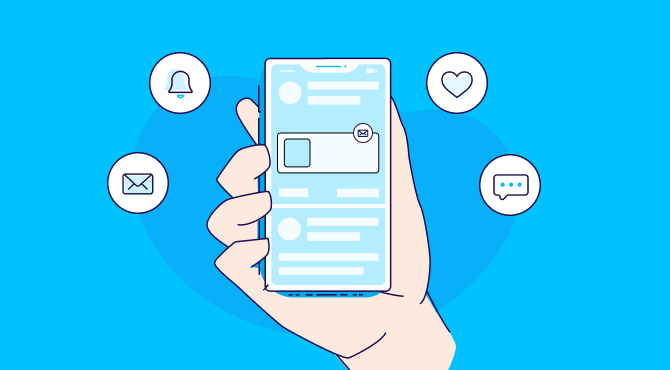
Utilize push notifications… tastefully
Notifications can be stressful. The average US smartphone user receives no less than 46 per day! But thoughtful notifications can be extremely helpful. For example, nobody will say no to a 50% discount on their next delivery order.
Whether it’s a limited-time sale, a special in-game event, or a reminder to check-out, push notifications are extremely effective to re-engage with your users at the right times.
So how much is too much? 10% of users disable notifications when receiving one notification per week, and 40% disable when receiving 3-6 per week. So you do the math.
But the truth is — it’s less about the number of notifications, and more about their purpose. So be intentional and mindful about when you send them out.
Paid re-engagement campaigns
Sometimes life gets in the way and your power users forget about your app. An effective paid re-engagement strategy can help get your most profitable users back to your app with a little nudge in the right direction.
You don’t want to waste your precious ad dollars re-engaging with every single user who stopped using your app. Instead, segment your audience to re-engage users who used to use your app frequently.
For example, let’s take a user who hasn’t initiated your game in the last 14 days but used to pay for a monthly membership. You can target them with a ‘welcome back’ bonus by offering in-game rewards.
Or, perhaps you run an ecommerce app. In that case, identify users who haven’t made a purchase in the past two months and offer a unique discount for their next order.

Chapter 5
Indispensable app marketing metrics you need to know
A successful app marketing plan is clear and measurable. With hundreds of confusing acronyms out there, which one should you focus on? Here are the ten most important app metrics to look out for:
- Click Through Rate (CTR): The share of users who viewed and clicked an ad. Although CTR may be considered a vanity metric, it’s an effective baseline measure of an ad’s creative performance.
Calculation: Number of clicks / Number of ad views
- Click to Install (CTI): The share of users who clicked and then installed your app. This measures the correlation between the two strongest touchpoints in your pre-install user journey. CTI helps indicate relevancy, app store performance, and loading times.
Calculation: Number of installs / Number of ad clicks
- Return on Ad Spend (ROAS): This measures the profitability in dollar amount of your ad spend to provide a high-level view of your campaign’s performance.
This is also a strong indicator of the quality of users you acquire. In other words, ROAS is the dollars spent on marketing divided by the revenue generated by users attributed to the marketing campaign — within a specific time frame.
Calculation: User-generated revenue from a specific campaign in given time frame / Total marketing spend
- Daily Active Users (DAU): A measurement of how many unique users engage with your app within a 24-hour period, which is commonly used for games or other apps that are used daily.
Calculation: Unique new users + unique returning users
Alternatively, Monthly Active Users (MAU) is an alternative metric that indicates the number of users who use an app within 30 days.
- Churn rate: the rate in which users are uninstalling your app, downgrading plans, or canceling subscriptions. Conversely, retention rates define how many users are continuing to purchase, upgrade plans, and renew subscriptions.
Calculation: total # of churned users / Total # of users
- Average Revenue Per User (ARPU): the average cash generated per user made through in-app purchases (IAP), ad impressions, ad clicks, subscriptions, or paid downloads. ARPU is an effective indicator in measuring the quality of users with a dollar amount.
Calculation: Revenue during a predefined period of time / Total # of users
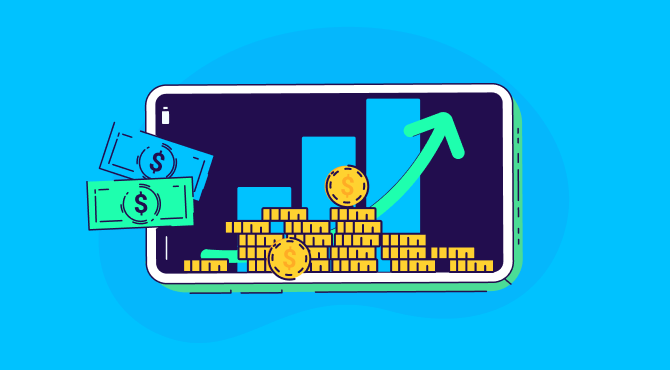
7. Purchase Frequency (PF): The frequency with which your users make purchases. This helps separate users who made zero purchases from your highest repeat purchasers.
PF is an effective indicator for user loyalty. Consider creating lookalike audiences for your highest PF users, and removing them from your remarketing campaigns (as they’re already engaged).
Calculation: Total # of purchases over a time period / Total # of users during the same time period
8. Lifetime Value (LTV): The total projected revenue a user will generate over a specific period of time. Since it’s cheaper to retain existing users than finding new ones, LTV helps you focus on attracting the most profitable users.
It also provides a framework for your ad spend, allowing marketers to calculate how much ad spend to dedicate to a campaign in order to remain profitable.
Calculation:
Step 1: Average purchase value = (Total revenue / Number of purchases)
Step 2: Average purchase frequency rate = (Number of purchases / Number of unique users)
Step 3: User value = Average purchase frequency rate x Average purchase value
Step 4: LTV = User value x Average user lifespan
9. Funnel conversion rates: The percentage of users progressing in each stage of your app funnel. This can be measured by mapping specific in-app events first and then measuring the conversion between the two events.
For example, you can measure install to purchase. This helps identify where users may be getting stuck in your funnel, which provides insight into where you can improve and optimize your app.
Calculation: (Total # of desired event conversions / Total # of initial events in the app) x 100

Key takeaways
- App marketing is the method of building awareness, acquiring new users, and retaining users of a mobile app through advertising, placements, and promotions.
- The app marketing funnel is split into three stages: awareness, acquisition, and retention.
- Every successful app marketing campaign begins with understanding your audience. Formulate your who, when, why, where, and how with as much research as possible.
- A successful app marketing plan is simple, clear, and measurable. Instead of drowning yourself in thousands of metrics, focus on a handful of the ones listed in Chapter 5 — that makes the most sense for your app needs.

